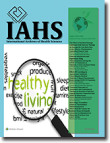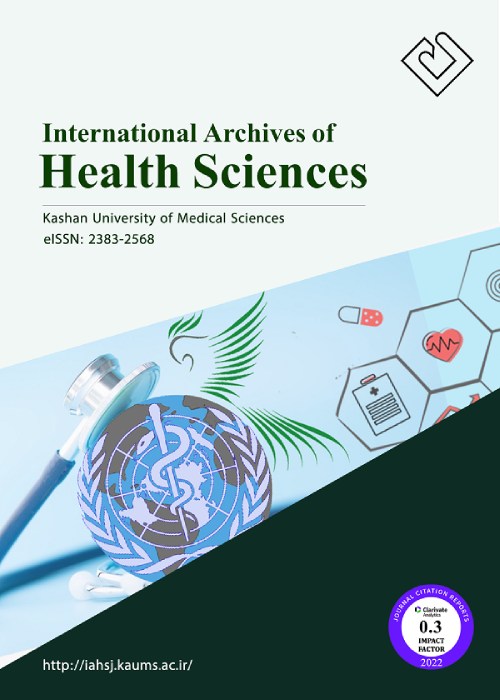فهرست مطالب

International Archives of Health Sciences
Volume:10 Issue: 1, Jan-Mar 2023
- تاریخ انتشار: 1401/12/13
- تعداد عناوین: 5
-
-
Pages 1-6Aims
The aim of this study was to determine the effect of Swedish massage combined with exercise therapy on nonspecific low back pain (NSLBP) in older adults.
Materials and MethodsThis randomized controlled clinical trial was carried out on 70 elderly people with NSLBP. Participants were assigned randomly to the intervention and control groups. The interventional group was treated using Swedish massage combined with exercise therapy, while the control group was treated using exercise therapy alone. The Visual Analog Scale (VAS) and the Quebec Back Pain Disability Scale (QBPDS) were used to determine the severity of low back pain (LBP) and the LBP disability, respectively. All participants were completed LBP and QBPDS scales for three times (at the beginning and the end of the intervention as well as 4 weeks after completion of the intervention).
ResultsIt was seen that the participants in the intervention and control groups were similar in baseline scores of VAS and QBPDS. Using repeated measures analysis of variance, the comparison of the mean scores of both the scales in the two groups indicated that the scores decreased significantly (P < 0.05) in the intervention group compared to the control group at the second and the third measurements.
ConclusionThe findings indicated that the Swedish massage combined with exercise therapy could be more effective for reducing LBP and back pain disability compared to exercise therapy alone. Further studies are needed to reach more evidence.
Keywords: Exercise, low back pain, Swedish massage, therapy -
Pages 7-13Aims
During the pandemic of COVID‑19, the sudden change in traditional health‑care providing systems, clinicians experience some positive and negative aspects of the approach. This study evaluates the clinician’s satisfaction and experience with the use of teleconsultation provided during the pandemic of novel coronavirus and their willingness to continue telehealth after the pandemic.
Materials and MethodsA cross‑sectional survey was conducted online during the peak pandemic of COVID‑19 in Pakistan through Google Forms questionnaire from 115 health consultants on different disciplines and recruited through social media. The questionnaire contains 15 questions regarding clinician’s satisfaction, quality of treatment, and intention to continue providing telehealth services after the pandemic. Descriptive and inferential statistics were obtained by analyzing the data using SPSS software version 20, USA.
ResultsOne hundred and fifteen consultants, 28 males and 87 females participated in the study, in which 62% were found to have an average and 34% at a high level of satisfaction. The Kruskal–Wallis test showed a significant difference among different medical specialists in the continuation of telehealth services after the pandemic of COVID‑19 (P = 0.003) and its recommendation to friends and family (P = 0.02) with high mean rank in endocrinologist and dermatologist.
ConclusionsA great number of participants reported a good response for the continuation in telemedicine services in their daily routine even after the pandemic situation. However, there is an urgent need to find the solution for the difficulties and drawbacks faced by health‑care providers.
Keywords: COVID‑19, pandemic, remote consultation, satisfaction, telemedicine -
Pages 14-19Aims
This study aimed to determine the effect of E‑learning on the understanding of appropriate antibiotic prescribing (AAP) by medical students and to assess their satisfaction with this method.
Materials and MethodsThis quasi‑experimental study was conducted among the physiopathology students of Kashan University of Medical Sciences in the first and second semesters of 2020–2021. Students were divided into E‑learning education as an intervention group (IG) and face‑to‑face education as a control group (CG). After the final examination, the mean scores of students in both groups were compared. In addition, the level of students’ satisfaction in the IG with E‑learning method was assessed using a standard questionnaire. Data were analyzed using SPSS 22.
ResultsWe included 85 and 47 students in the CG and IG. The mean and standard deviation (SD) of the understanding score about antibiotics in the E‑learning group and the face‑to‑face education group were 18.8 ± 1.26 and 17.16 ± 1.93 out of 19, respectively, which were statistically significantly different (P = 0.004). The mean and SD of the overall score of satisfaction of the students in the IG was 85.48 ± 23.08 out of 130 points (medium level). Furthermore, the level of satisfaction of male students was significantly higher than female students (P = 0.009).
ConclusionE‑learning was effective in improving the process of educating students to the AAP. This education method can be used as an alternative or complementary of face‑to‑face education, especially in critical conditions such as the pandemic of diseases including COVID‑19.
Keywords: Antibiotic, antibiotic prescribing, COVID‑19, E‑learning, medical students -
Pages 20-24Aims
Internet gaming disorder (IGD) is an increasingly concerning mental health problem which has the highest prevalence among adolescents. In the DSM‑5, a diagnostic criteria are proposed for this disorder for the first time, and it is placed in the position of a potential behavioral addiction. No standard treatment for the disorder has been identified yet. The acceptance and commitment therapy (ACT) is shown to be effective in some behavioral addictions in different age groups. Given the high association between IGD and attention‑deficit hyperactivity disorder (ADHD), we assessed the effect of ACT on the severity of IGD comorbid with ADHD in adolescents.
Materials and MethodsTwenty adolescents aged 12–18 years with IGD comorbid with medically‑controlled ADHD underwent ACT weekly for 8 weeks. For each individual, two separate questionnaires for IGD and ADHD were filled out, once at the beginning, and once at the end of treatment. The results before and after treatment were compared together.
ResultsThe mean scores of the IGD questionnaire before and after the intervention were 37.25 and 30.30, respectively, and the mean difference was statistically significant (P < 0.001). The mean score of ADHD index and its three subscales were under the diagnostic cut‑point of the disorder before and after the treatment. However, the mean score of ADHD index, hyperactivity, inattention, and oppositional behavior decreased by 1.80 (P = 0.0013), 1.45 (P = 0.114), 1.90 (P = 0.027), and 2.05 (P = 0.023), respectively.
ConclusionThe results showed a significant effect by the ACT on reducing the severity of IGD in adolescents with underlying medically controlled ADHD.
Keywords: Acceptance, commitment therapy, adolescent, attention deficit‑hyperactivity disorder, Internet gaming disorder -
Pages 25-30Aims
The aim of this study was to determine the fauna and bioecology of sandflies in Khorramshahr County, southwest of Iran, where cutaneous leishmaniasis (CL) is endemic.
Materials and MethodsSandflies were caught indoors and outdoors by sticky paper traps in different areas. Sandflies were removed by needle and put in acetone and then transferred and preserved in 70% ethanol. In the laboratory, they were mounted in the Puri’s medium and identified using identification key. The species richness, relative abundance, monthly prevalence, gender, and abdominal situation of sandflies in indoor and outdoor resting places were determined.
ResultsA total of 7172 sandflies representing 11 species were collected in 11 areas. Almost 29.9% of sandflies were collected from indoor places and 70.1% from outdoor places. About 60.8% of the specimens were Phlebotomus species while 39.2% were Sergentomyia. Phlebotomus papatasi and Sergentomyia sintoni were the most common species among Phlebotomus and Sergentomyia genera, respectively. The highest sex ratio was 1100 for Sergentomyia theodori. In total, 53.7% of sandflies were male and 46.3% were female. The majority of captured sandflies collected from indoor and outdoor places had an unfed stomach. The sandflies were more active in June and September.
ConclusionMore detailed studies on leptomonad infection of the suspected vectors and amastigote infection of the potential reservoirs of the CL are recommended to detect the epidemiological characteristics of the disease in this county.
Keywords: Ecology, Iran, sandfly, sex ratio, species composition


